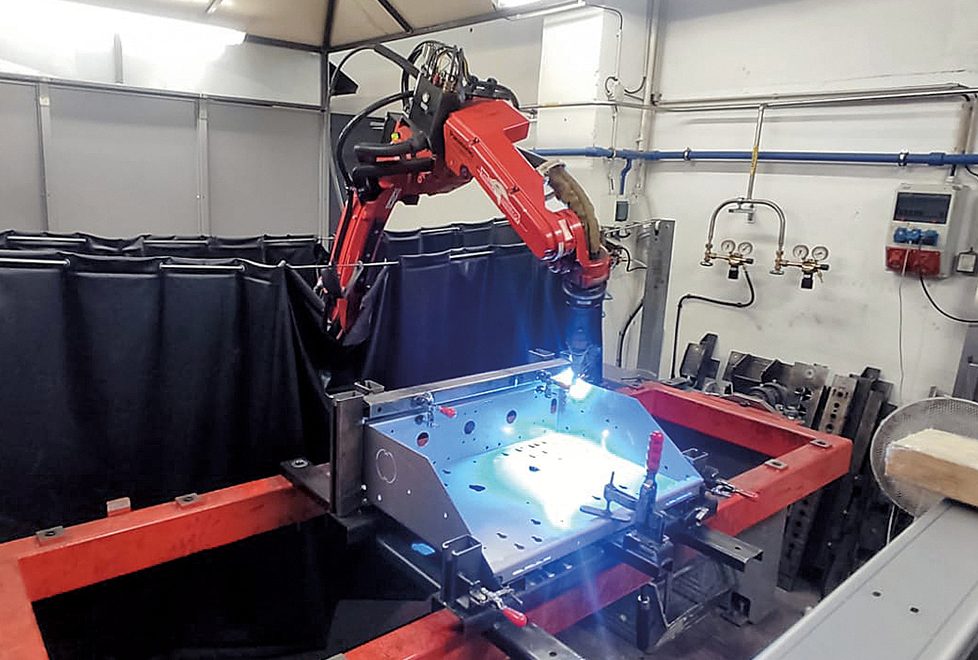The welding robot will never have to stand still again
SixPointTwo has commissioned a second welding robot
SixPointTwo now has two welding robots, both supplied by Valk Welding. Why are welding robots indispensable? Can they get any more efficient? Ad van Boxel, Technical Adviser at Valk Welding, shares his thoughts.
 SixPointTwo first approached Valk Welding in 2016. The expansion of our production capacity necessitated additional welding capacity. “Especially the welding for serial production runs”, says van Boxel. A further increase in production led to the purchase of a second welding robot in 2021. “Like the first, this is also a complete welding robot system in which the welding robot is mounted on a stable H-frame. We also supplied DTPS: the software package for offline programming.”
SixPointTwo first approached Valk Welding in 2016. The expansion of our production capacity necessitated additional welding capacity. “Especially the welding for serial production runs”, says van Boxel. A further increase in production led to the purchase of a second welding robot in 2021. “Like the first, this is also a complete welding robot system in which the welding robot is mounted on a stable H-frame. We also supplied DTPS: the software package for offline programming.”
Efficient use of time
How does the performance of welding robots compare to the performance of professionals? “Research has shown that a manual welder is actually welding 15% to 20% of their time. The remaining time is spent on other activities, such as loading and measuring the product. A well-managed robot installation, on the other hand, uses 70% to 80% of the start-up time for welding.” If you consider that skilled welders are increasingly difficult to find, and that they stop work every day after eight hours, you will understand why welding robots are indispensable. “A welding robot just keeps going. Depending on the production order, you can press start, turn off the lights and go home.” You no longer need a qualified welder for the human actions that have to be performed on the robot installation. “Any operator can perform them.”
Offline programming for extra production time
DTPS, the software package for offline programming, saves SixPointTwo even more time. “There are two programming options: online and offline programming. Online programming is done on the robot itself. The robot can’t be used for production during programming.” Offline programming doesn’t have that disadvantage. “This eliminates downtime. While the machine is running, you can programme on the PC. And when the programme’s ready, you send it to the welding robot.”
Always find the weld seam
First time right was an important performance requirement for SixPointTwo when choosing the welding robot system. “Our welding robot is equipped with Quick Touch Sensing. This means it can anticipate tolerances. Using the welding wire, it first searches for the product to determine where the weld seam is. The programme is therefore automatically adjusted for each weld seam, which means you get a perfect weld. It always finds the weld seam.” According to van Boxel, this is exactly what metal companies need. “As an example, sheet metal settles and always has many deviations. This welding robot can deal with these easily.”
Measure and check
It’s also important that the robot maintains control over the process. “This is because the welding source and the robot communicate with each other. The robot adds welding wire if necessary, and will stop automatically if there’s a problem or it runs out of welding wire.” In addition, the welding robot is equipped with Automatic Tool Control. “This programme lets the robot check whether the tool (the welding torch) is still in the original position on the robot arm. As a user, you can set the desired frequency of checking yourself. If problems are found, the robot will report them. The user can then repair it or have it repaired.” ATC ensures the robot continues to deliver the same performance from the moment of delivery. “A torch that isn’t in the right position shouldn’t be allowed to produce abnormal results.”
Under development
Valk Welding has offices in Poland, Sweden, Denmark, Germany, the Czech Republic, France, the Netherlands, Belgium and Ireland. The company only supplies welding robots from Panasonic. “Our relationship with Panasonic dates back to 1988. Our management team forms a part of the Panasonic development team. We’re therefore thoroughly familiar with their systems. All our technicians are trained to work with them. If a customer has a problem, we can solve it.”
Developments are moving quickly. Valk Welding is committed to fully automated offline programming. “To make it even easier for our customers, we want to shorten programming times for a large number of applications. In our steel construction, we’ve already reached the point where programmes can be generated offline using 3D packages.” In a new step forward, if all our production programmes can be made offline, the welding robot can also be considered ideal for single-piece production and it will never have to stand still again.

